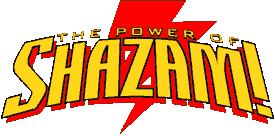
 The Guide To Comics, in issue 23, cover date July, 1993 came an article of Jack Curtin. At the end of the article, Wizard stated that he is a freelance writer and comic book collector, then based near Philadelphia.
The Guide To Comics, in issue 23, cover date July, 1993 came an article of Jack Curtin. At the end of the article, Wizard stated that he is a freelance writer and comic book collector, then based near Philadelphia.
This is an excellent introduction to the character, to the excitement! I would like to reproduce it, so everybody could read it. The new fans who are discovering the original Captain Marvel will find interesting facts of the history of this great character; for the old fans, this well written article will bring you back memories of good times, and will provide some facts that will make you smile, feel sorry or even get mad! Respectfully, to both his original author and original publisher, I've transcribed exactly each word as published back on 1993.
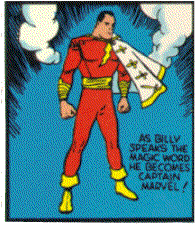
IT'S THE BIG RED CHEESE!
We're talking Captain Marvel here, friends -- the superhero they can't get right. Trey've tried duplicating the feel of those long-ago adventures, throwing out the old stories, and probably a few other variations, but since his original disappearance in the mid-1950's, nobody has achieved the same success.
 Oh, sure, Superman is, and will always be, the ultimate comics hero. (That's the "real" Superman, of course, not this new guy who can apparently lose either his life or his cape and replace both as necessary.) But Supes was a grown man, and not even a human, for that matter. A kid could worship him in wide-eyed wonder, but he couldn't really imagine being him. Captain Marvel, on the other hand, was not only human (the editors tagged him "The World's Mightiest Mortal", perhaps in a slap at the Kryptonian), he was a kid in a man's body, thanks to an old wizard and a magic word. Hey, any boy worth his salt could figure there was at least a chance that somebody could come along and give him the magic word that would make him big enough and tough enough to handle all the strange goings-on in the adult world and still, inside, be himself. Captain Marvel was a daydream with muscles.
Oh, sure, Superman is, and will always be, the ultimate comics hero. (That's the "real" Superman, of course, not this new guy who can apparently lose either his life or his cape and replace both as necessary.) But Supes was a grown man, and not even a human, for that matter. A kid could worship him in wide-eyed wonder, but he couldn't really imagine being him. Captain Marvel, on the other hand, was not only human (the editors tagged him "The World's Mightiest Mortal", perhaps in a slap at the Kryptonian), he was a kid in a man's body, thanks to an old wizard and a magic word. Hey, any boy worth his salt could figure there was at least a chance that somebody could come along and give him the magic word that would make him big enough and tough enough to handle all the strange goings-on in the adult world and still, inside, be himself. Captain Marvel was a daydream with muscles.
 The Big Red Cheese (as his most consistent enemy named him early on), along with his extraordinary array of siblings, surrogates, and sinister schemers, filled the pages of a variety of titles from Fawcett Comics from the very early days of the Golden Age (1940) right on through to its dying gasp (1953). Cap's own book even outsold Superman there for a while, something unheard of in those halcyon days. All of this, of course, was through sales off the newsstands and not via specialized stores catering to the knowledgeable and pushing the product.
The Big Red Cheese (as his most consistent enemy named him early on), along with his extraordinary array of siblings, surrogates, and sinister schemers, filled the pages of a variety of titles from Fawcett Comics from the very early days of the Golden Age (1940) right on through to its dying gasp (1953). Cap's own book even outsold Superman there for a while, something unheard of in those halcyon days. All of this, of course, was through sales off the newsstands and not via specialized stores catering to the knowledgeable and pushing the product.
In many ways, the Captain Marvel Universe was ahead of its time. Stories were dependent upon continuity before continuity was anything more than an idea most of the writers of the day shuddered to contemplate. Cap starred in one of the classic serials in comics history, running for 23 issues over parts of four calendar years in an era when continued stories were considered the kiss of death. The Fawcett line routinely featured guest appearances and crossovers of both heroes and villains before there was even a word to describe such things.
And yet, as every obscure costumed clown from the past continues to be revived, revitalized, and reborn for the modern day audience, Captain Marvel and his whole universe remain a disaster area.
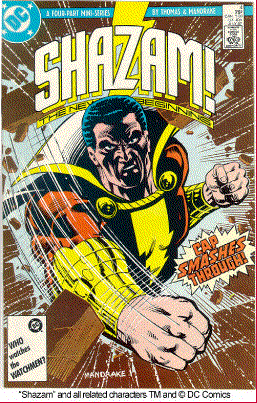
There are several reasons, not the least of which is that times have changed. One of the key elements in almost every one of those other revivals is the process of making the hero grim n' gritty, harder than nails, and meaner than Pat Buchanan in heat. Cap and friends will never fit that mold. There just may not be a place for a good old fashioned hero in today's comics (and just think about that for a while, if you want to get depressed).
A second major factor is the blind and obsessive conviction these days that every single superhero published by a company has to inhabit the same universe as all the others. Let's face it -- a series which features, at one time or another, a kid newscaster; a talking tiger who wears sports coats; a big old rock out in space that serves as the nexus for the past, present and future (The Rock of Eternity); and a small, flexible invertebrate with no appendages as the ultimate villain (more about him later) is not exactly tailor-made for interacting with the usual bunch of DC suspects.
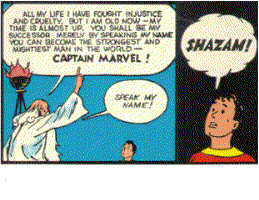 But let's start at the beginning. No, not with Billy Batson walking down that long, dark subway tunnel toward his destiny, but with the people who put him in there.
Captain Marvel was born in late 1939 and was the brainchild of Bill Parker, then the editor of Fawcett's faltering line of humor magazines. Parker was asked to come up with a new superhero so that the company could break into the new and growing comic-book market. It's interesting to note that, while it has been forgotten or overlooked in most tellings of the story, Parker originally conceived of Cap as the leader of a team of lieutenants, each one possessing a power similar to that of a classic Greek mythological figure. The team idea was rejected as too cumbersome -- try imagining that happening today!
But let's start at the beginning. No, not with Billy Batson walking down that long, dark subway tunnel toward his destiny, but with the people who put him in there.
Captain Marvel was born in late 1939 and was the brainchild of Bill Parker, then the editor of Fawcett's faltering line of humor magazines. Parker was asked to come up with a new superhero so that the company could break into the new and growing comic-book market. It's interesting to note that, while it has been forgotten or overlooked in most tellings of the story, Parker originally conceived of Cap as the leader of a team of lieutenants, each one possessing a power similar to that of a classic Greek mythological figure. The team idea was rejected as too cumbersome -- try imagining that happening today!
In another of those odd little coincidences that comics historians love, Cap (originally named "Captain Thunder"), made his initial appearance in Flash Comics, a black-and-white "ashcan edition" officially published in January 1940. The name had to be changed, of course, because DC (All-American Comics, to be historically accurate) came out with the "real" Flash Comics that same month. After another duplicate title effort (Thrill Comics), Fawcett finally came to the newsstands with Whiz Comics # 1 in February 1940. (That ashcan version of "Flash Comics" was the official # 1)
From the very beginning, Captain Marvel's chief artist was the man most identified with him throughout his career, C.C. Beck, a grand and wonderful cartoonist whose style was perfect for the character, somehow capturing exactly the essence of the boy inside the man which was fundamental to Cap's innocence and na´ve lack of sophistication. Beck and his assistant, Fawcett staff artist Pete Costanza, were key contributors to Cap's origin and success. When veteran science-fiction writer Otto Binder succeeded Parker as the primary chronicler of the Marvel Saga, the series reached the heights for which it is famous to this day. Other writers and artists (chief among the latter being Kurt Schaffenberger and Mac Raboy) all played their parts in the series, but it is the work of Binder and Beck that is the essential Captain Marvel.
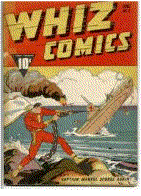
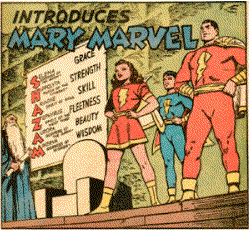 Readers with an interest in the early stories (and with 50 bucks to spend) can experience the first 15 Parker-written stories from Whiz in DC's recently released The Shazam Archives, Volume 1. You can literally see Beck's and Costanza's art improving from story to story as they get a feel for the character and his world. The stories themselves are simple, straight-forward, and, in a sense, about a different character from the Cap the world came to know and love. The "real" Captain Marvel would never have put on a tuxedo and taken a beautiful woman on a date as he does in the story from Whiz # 15, for example. Still, the elements are all there: old Shazam, Billy Batson, Mr. Sterling Morris and radio station WHIZ, and, most specially, Cap's classic enemy, Dr. Thaddeus Sivana (along with two children who soon disappeared to be replaced by the more villainous, Sivana Jr. and Georgia).
Readers with an interest in the early stories (and with 50 bucks to spend) can experience the first 15 Parker-written stories from Whiz in DC's recently released The Shazam Archives, Volume 1. You can literally see Beck's and Costanza's art improving from story to story as they get a feel for the character and his world. The stories themselves are simple, straight-forward, and, in a sense, about a different character from the Cap the world came to know and love. The "real" Captain Marvel would never have put on a tuxedo and taken a beautiful woman on a date as he does in the story from Whiz # 15, for example. Still, the elements are all there: old Shazam, Billy Batson, Mr. Sterling Morris and radio station WHIZ, and, most specially, Cap's classic enemy, Dr. Thaddeus Sivana (along with two children who soon disappeared to be replaced by the more villainous, Sivana Jr. and Georgia).
As noted earlier, serialized stories were an early innovation at Fawcett. In the very same issue that ends the first Archive collection, Whiz # 15, there's a Spy Smasher story that begins a three-issue, six-part crossover with the lead Captain Marvel feature. In it, Spy Smasher is hypnotized into becoming an enemy agent and has to be stopped by Cap. Cap joined forces with another Fawcett hero, Bulletman, to fight Captain Nazi in Master Comics # 21, leading to the birth of Captain Marvel Jr. in the Whiz # 25 and an immediate corssover to Cap Jr.'s own strip and a Captain Nazi battle in Master # 22.
But all that paled beside what happened in Captain Marvel Adventures # 22, cover dated March 1942. That issue marked the first chapter of "The Monster Society of Evil", a 25-installment serial that did not end until # 46, cover dated May 1945. In those days, comics had many more pages (averaging 64 pages per issue) and always carried several stories. Each chapter in the series was just one of four or more Cap stories per issue, rather that tying the writers' efforts into one storyline. What was truly mind-boggling about it all, though, was the identity of the evil Mr. Mind, a being from space bent upon conquering the Earth and organizing Cap's greatest enemies against him. Not until chapter six (in Captain Marvel's Adventures # 27) did Cap and the readers learn that Mr. Mind was... a worm!
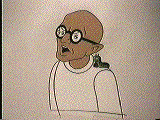 This classic serial has been collected in a single volume, The Monster Society of Evil, from the American Nostalgia Library. Originally offered at prices in excess of $100.00, it is currently available for considerably less from sources such as Bud Plant.
This classic serial has been collected in a single volume, The Monster Society of Evil, from the American Nostalgia Library. Originally offered at prices in excess of $100.00, it is currently available for considerably less from sources such as Bud Plant.
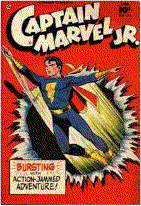 To put it as nicely as possible, Cap Jr. was always something of an oddball. Every other Marvel in the World, except for the villainous Black Adam, wore red; he wore blue. All the other Marvel stories were told in the more simplistic, cartoony style of Beck, Costanza, and Shaffenberger; Junior had his adventures illustrated by Raboy, one of the finest realistic artists in comics history. But the wackiest thing of all was that Junior was a hero who couldn't even say his own name! Every other Marvel around said "Shazam!" to bring down the magic lightning; he said "Captain Marvel!". Think about that for a minute: "Hi there, I'm...err...umm"
To put it as nicely as possible, Cap Jr. was always something of an oddball. Every other Marvel in the World, except for the villainous Black Adam, wore red; he wore blue. All the other Marvel stories were told in the more simplistic, cartoony style of Beck, Costanza, and Shaffenberger; Junior had his adventures illustrated by Raboy, one of the finest realistic artists in comics history. But the wackiest thing of all was that Junior was a hero who couldn't even say his own name! Every other Marvel around said "Shazam!" to bring down the magic lightning; he said "Captain Marvel!". Think about that for a minute: "Hi there, I'm...err...umm"
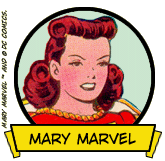 As for Mary, who made her debut in Captain Marvel Adventure # 18, perhaps the most unusual thing about her was that she was not the stereotypical female superhero, scantily clad and shapely. Hell, Mary was usually drawn more flat-chested than Cap and Junior. Shaffenberger, one of the primary artists for The Marvel Family title, did giver her at least the hint of a few curves here and there, something that all of us younger lads appreciated.
As for Mary, who made her debut in Captain Marvel Adventure # 18, perhaps the most unusual thing about her was that she was not the stereotypical female superhero, scantily clad and shapely. Hell, Mary was usually drawn more flat-chested than Cap and Junior. Shaffenberger, one of the primary artists for The Marvel Family title, did giver her at least the hint of a few curves here and there, something that all of us younger lads appreciated.
There were important matters that every fan of the Marvels had to think about. One was this: Billy was a boy who turned into a man when he said the magic word, but both Mary and Junior remained kids, albeit ones with super powers. Why did they ever -- especially Junior, who was a crippled newsboy in his real life -- change back? Why not just change clothes? The other big puzzle was: how come, no matter what ingenious death trap the bad guys set up for the kids once they captured them (which they did with alarming regularity), they always took the trouble to gag them? Did these guys know more than we thought, or were they just particularly efficient?
 Captain Marvel met his end in 1953, done in not by one of his super-powered foes or the evil genius of Sivana, but by one of mankind's deadliest enemies: lawyers. He can be seen as a victim of both success and failure.
Captain Marvel met his end in 1953, done in not by one of his super-powered foes or the evil genius of Sivana, but by one of mankind's deadliest enemies: lawyers. He can be seen as a victim of both success and failure.
His success in the marketplace originally led DC Comics to file a suit charging Fawcett with the copyright infringement; Cap was too similar to Superman, they said, Fawcett won consistently in lower courts, but DC pursued the battle ever higher in the legal system. Awarding judgment to DC might have required arguing that every super-powered hero was an infringement on Supes. However, the suit wasn't settled until the comics industry was in the last days of the Golden Age and Fawcett apparently didn't have the heart for the struggle. Fawcett caved in, canceling not only the Marvel Family titles but its entire comics line.
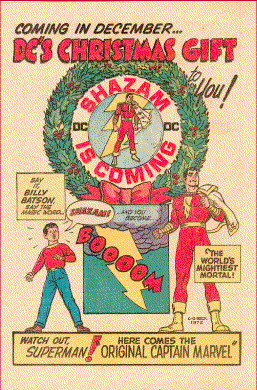
Captain Marvel remained in limbo for two decades, although there was one truly abominable new character using his name in 1966. The "Captain Marvel" published by M.F. Enterprises was a four issue wonder whose super power was the ability to split himself into pieces. Marvel Comics has done a couple of Captain Marvel version of its own over the years (and registered the name, forcing the real Cap to appear in comics and on television under the Shazam! banner). But DC has controlled his destiny since the suit and didn't resurrect the original until 1973, an abortive attempt that fizzled when fans didn't respond as hoped and Beck, brought back to do the art, quit in a snit.
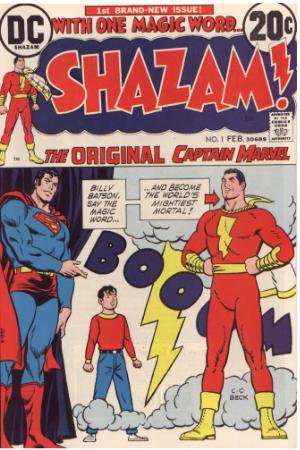
DC's original revival attempt was pretty well done. With writers like Denny O'Neil, E. Nelson Bridwell and Elliot S! Maggin and art by Beck, Shaffenberger, and Bob Oksner, Shazam! seemed to capture a lot of the Golden Age spirit. Most fans didn't seem to agree or care, and neither -- most vociferously -- did Beck. When he quit after 10 issues, the project was clearly doomed. Beck's action was very strange and seemingly out of character. Whenever he talked about the Fawcett years, Beck was quick to deny any part -- or interest -- in the development of the character or the plotting and writing of the stories, but it was the stories he objected to in 1973, and he could not be won over.
Shazam! lasted for five years and 38 issues. After the title ended in 1978, Cap and his family sort of hung around the DC edges, dwelling on Fawcett-Earth (one of those useful Pre-Crisis alternate worlds where DC could deal with characters outside its mainstream.
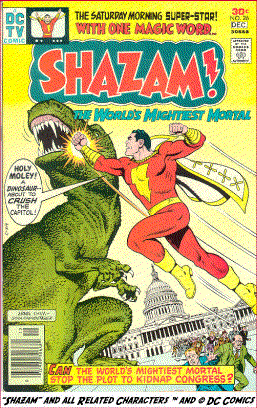
In 1987, in conjunction with its Legends crossover series, DC spun off a truly awful new revival attempt. Shazam: A New Beginning was written by Roy Thomas, a guy who is usually very sharp in locking into the Golden Age versions of things but who lost his way terribly here, by presenting a much bleaker version of Billy Batson and his world. From that point on, Cap has just sort of been there, in the DC Universe but not quite connecting with it. He was surprisingly well-handled as a member of Justice League America in the early issues of that title, but, most of the time, he just seems lost.
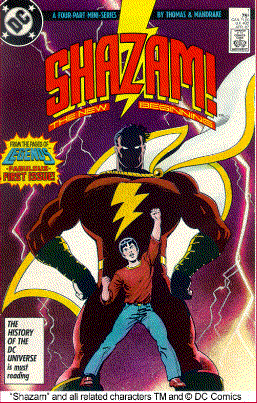
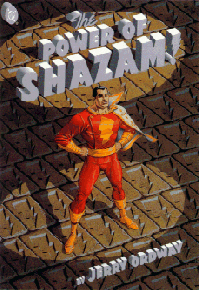 DC has been fumbling and stumbling with the character for two decades now, mostly getting hung up on the foolish attempt to incorporate the Marvel troupe into the DC Universe. How can a group that includes talking tigers and megalomaniac alien worms fit in with the likes of Batman and Lobo? The Jerry Ordway graphic novel that has been much hyped for more than a year now has yet to see print as this is being written. The encouraging news is that Ordway, as both writer and artist and looking at his work on Superman in recent months, seems to have the skills to do a Cap for the '90's-- is given a free hand.
DC has been fumbling and stumbling with the character for two decades now, mostly getting hung up on the foolish attempt to incorporate the Marvel troupe into the DC Universe. How can a group that includes talking tigers and megalomaniac alien worms fit in with the likes of Batman and Lobo? The Jerry Ordway graphic novel that has been much hyped for more than a year now has yet to see print as this is being written. The encouraging news is that Ordway, as both writer and artist and looking at his work on Superman in recent months, seems to have the skills to do a Cap for the '90's-- is given a free hand.
Captain Marvel was once an exemplar of what superhero comics can and should be. He ought to be given the chance to try again.
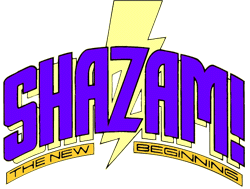
To the Home

Want to know more about the World's Mightiest Mortal?